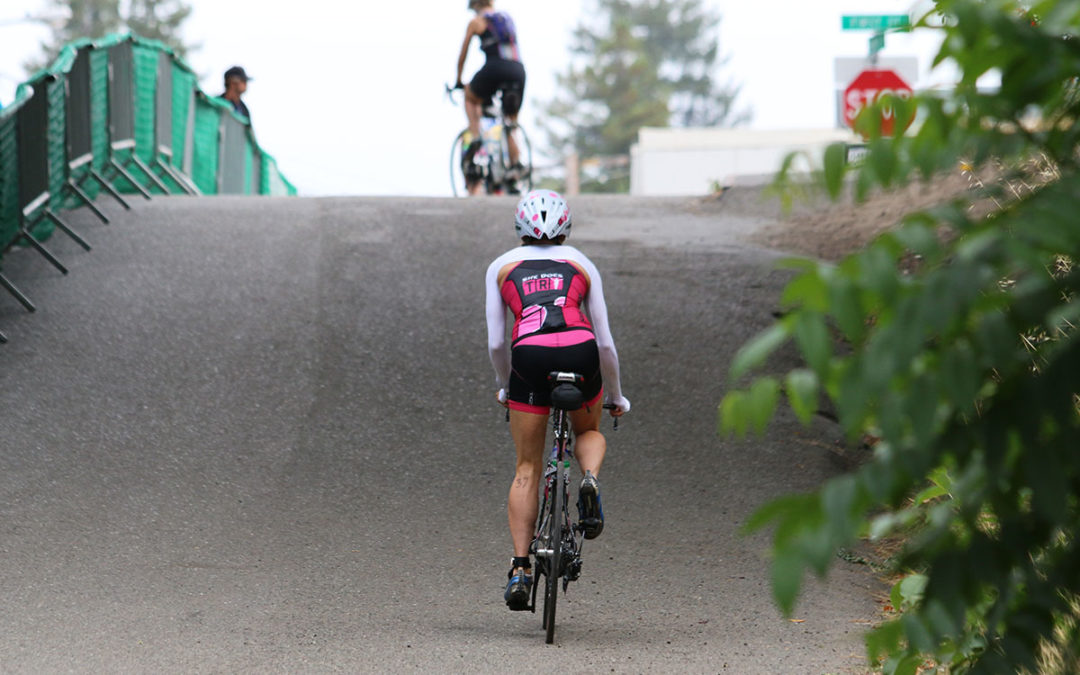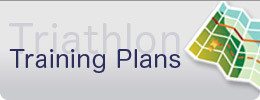There are three positions to choose from while riding a triathlon bike:
- Down in the aero bars,
- Seated while holding the base bars and
- Standing.
In a typical race, you should aim for spending the largest percent of your time in the aero bars, as this low profile position gives you the best aerodynamic advantage. However, spending too much time in the aero bars can wreak havoc on your lower back, glutes and shoulders, and it isn’t as biomechanically efficient on long climbs, short and punchy rollers or for building speed out of sharp corners.
When to Stand While Riding During a Race
Standing out of the saddle should be chosen carefully in a race, as it presents the largest possible surface for wind resistance to slow you down. However, it is sometimes the best position to take in certain instances, such as getting back up to speed after braking for a corner.
Here are our suggestions on when to stand:
- After braking for a corner: Stand up for three to five seconds as you exit the corner to get back up to speed quickly. This only needs to be done when your speed drops considerably. There is no need to stand out of a corner when your exit speed is greater than 20 miles per hour. Additionally, standing out of corners allows you to rest and stretch your back briefly.
- Breaking up a long climb: Longer climbs can be broken up with periods of time out of the saddle, and then back in the saddle with hands on the base bars. Keeping an upright position will allow you to generate lots of power, take in plenty of oxygen and loosen the muscles that tightened fatigued while you were in the aero bars earlier.
- Steep climbs: If you ever watch a professional bike race on TV, you’ll notice that when riders “attack,” they generally do so by getting out of the saddle. This is true on climbs and on the flats. We don’t really attack during triathlons, but we do often need to generate lots of power to get over short and steep climbs. Doing this out of the saddle may be the best choice depending on how long the climb is.
- Loosen up your low back: Even on dead flat courses, standing up to let your lower back and glutes loosen up is important. Depending on your comfort level in the aero bars, you should aim to stand up (or at least get up the base bars while seated) once every 15-20 minutes. This is also done to relieve pressure on your groin. During training, standing up more often is a necessity to maintain your comfort level.
Choosing the Correct Gearing for Standing
If your normal cadence is 80-90 on the flats while in the aero bars or seated, your cadence while climbing out of the saddle will be somewhere between 60 and 80. Choose a gear that allows your foot to make smooth pedal strokes. If your foot is instantly dropping to the bottom of the revolution, you’re in too small (easy) of a gear.
Another way to choose a gear if you’re already on a climb (while seated) is to simply click down the rear cassette twice (getting into a harder gear) before standing up. That is likely the right gear for out of the saddle climbing.
Improving Your Out of the Saddle Power
If you find that you have to immediately sit down while climbing, and you can’t sustain a standing position for more than 30 seconds, you should consider building your out of the saddle power.
Challenge yourself to stand for one minute, then sit for one continuous minute. As you get better, increase the time that you stand during training to two minutes then three straight minutes. After a few weeks, you’ll already be on your way to drastically improving out of the saddle power and efficiency.
Good luck!
David
P.S. Need a purposeful training plan that takes the guesswork out of your training and gives you structure to reduce risk of overtraining and injury? Check out our training plans for triathlons from sprint to IRONMAN® and running races from 5k to marathon.
—
 Coach David Glover, MS, CSCS has completed 28 IRONMAN distance triathlons, which includes two sub 9 hour finishes and winning Vineman Full twice. Now, David’s passion now is helping triathlete and other endurance athletes achieve their dreams through his online triathlon education and training company, ENDURANCEWORKS. David has an MS in Exercise Physiology and is certified as a coach by IRONMAN Triathlon, USA Triathlon and USA Cycling plus has his CSCS from NSCA. After six years of living, training and coaching in the triathlon mecca of Boulder, CO, David currently resides in Southern California.
Coach David Glover, MS, CSCS has completed 28 IRONMAN distance triathlons, which includes two sub 9 hour finishes and winning Vineman Full twice. Now, David’s passion now is helping triathlete and other endurance athletes achieve their dreams through his online triathlon education and training company, ENDURANCEWORKS. David has an MS in Exercise Physiology and is certified as a coach by IRONMAN Triathlon, USA Triathlon and USA Cycling plus has his CSCS from NSCA. After six years of living, training and coaching in the triathlon mecca of Boulder, CO, David currently resides in Southern California.


